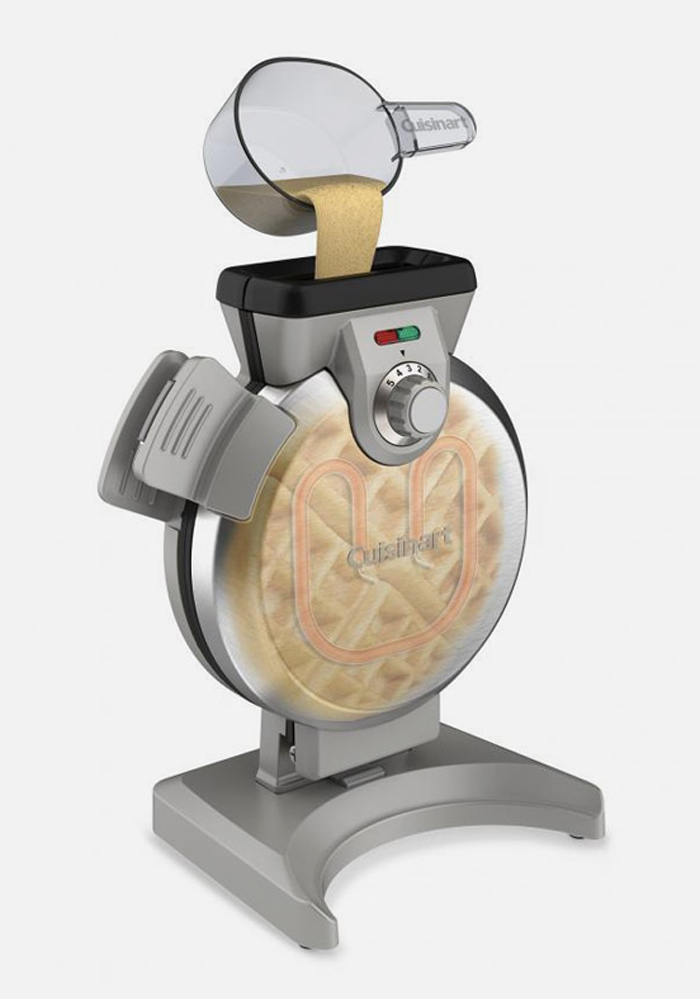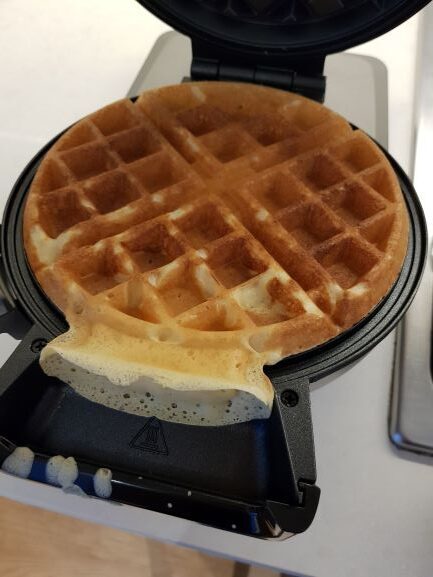Get our independent lab tests, expert reviews and honest advice.
Cuisinart Vertical Waffle Maker review

CHOICE verdict
An easy-to-use vertical Belgian waffle maker that’ll save precious space on your kitchen bench. It’s suitable for a range of recipes from traditional to banana waffles. Fine-tuning the mix to your requirements may take some practice though, and it’s important not to overfill it as the batter will expand during cooking. The supplied measuring cup should help with calculating the amount you need.
Price: $139
Contact:
cuisinart.com.au
What defines a true Belgian waffle is open to debate, but the ones served up in American diners are generally what we’re familiar with today. Based on Belgium’s ‘Brussels’ waffle, they were introduced to the US at New York World’s Fair in 1964. The concoction is light and airy, made with whipped egg whites and a leavening agent like baking powder.
The real indulgence is adding rich syrup or loads of sugar on top.
While waffle makers are common, the difference with the Cuisinart Vertical Waffle Maker is that it sits upright on your bench, taking up less room. And instead of pouring the batter directly onto an open grill, where you need to be careful to not spill the mixture, you pour the batter into a spout on the closed grill, allowing the mixture to spread evenly across the interior surfaces.
With home cooking being taken to the next level during lockdown, we decided to take a look at how easy the waffle maker is to use, and whether it actually does produce great-tasting waffles.
Our small appliances expert Matthew Tung took one home to review (and taste the results with his family).

How does it work?
Plain flour has been hard to come by at supermarkets during the pandemic, but Matthew was still able to make some great-tasting waffles with off-the-shelf pancake mix by adding butter and sugar, and reducing the amount of water. He was also able to follow one of the supplied recipes by using self-raising flour in place of baking powder and plain flour.
- Preparing the batter is the most time-consuming part of the exercise, depending on what you’re making. The traditional waffle recipe requires you to whisk the egg whites until they are peaky, which is best achieved with a hand mixer.
- Pre-heat the closed waffle maker by choosing your required browning setting (from 1 to 5). It’ll beep five times when it’s ready, and the indicator light will turn green.
- Once the batter is prepared, you need to fill the supplied measuring cup and pour the mixture into the waffle maker’s filler spout. The measuring cup is a bit tricky to use; with most batters it needs to be filled to the brim to make sure you’ve got the right amount. This means you need to make sure it is quickly poured into the filling spout using a steady stream to avoid spillage. With thicker batters you may not be filling the measuring cup quite so fully, but you’ll need to add it in gradually, making sure it’s gone through the fill spout before adding more. Adding less batter is preferable, as it expands during cooking and may spill over into the fill spout. Matthew found that some experimentation was needed.
- The alarm will beep five times when the waffle is ready. Although there is a bit of leeway when you’re making one on a low setting or with less sugar, it’s best to tend to the waffle right away if you’re cooking on the darkest level, as it could become slightly burnt. Removing the waffle with a plastic spatula or wooden spoon is easy, as it’s a non-stick surface. The result is one giant round waffle with deep pockets which can be cut into quarters.
With a regular-style waffle maker you might be tempted to open it from time to time to check on progress (which isn’t recommended anyway, due to the leavening agent in use). But opening a vertical maker too early risks the batter spilling out, so you just have to trust that it’s doing its job.

What can I make in it?
The suggested recipes that come with the appliance have an American audience in mind, with virtually every meal requiring the ubiquitous cornmeal (sold as polenta in Australia) and nutritional information supplied in calories. Recipes include buckwheat waffles, lemon-poppy seed waffles and spicy cheddar waffles.
Matthew found that for his family of three, it was preferable to halve the recipe as there was too much batter and making a second round of waffles wasn’t necessary. Luckily, it appears the Vertical Waffle Maker is versatile enough to successfully accommodate a range of mixtures, so long as you’re willing to experiment a little and make sure you don’t overfill the waffle maker.
Matthew enjoyed making the waffles and his young daughter had fun helping with the batter, but his family has had enough of eating them for now!
How safe is it to use?
As with many benchtop appliances, the exterior can get dangerously hot. On the highest setting, the outside reached 85.2°C. The hot plate itself reached 195.8°C.
When the waffle is ready (which can take about four minutes depending on what you’re making and the browning level), you can access the ‘stay-cool latch’ to safely open the appliance without having to touch the surfaces, but care must still be taken.
Cleaning must be done only once it has completely cooled, after which any remnants in the grids can be easily removed with a cloth. Batter that’s spilled into the spout takes a bit more work to clean up.
During operation, a red indicator light shows that it’s on, while a green light indicates that it’s reached the desired temperature. It will beep five times when the waffle is ready.






